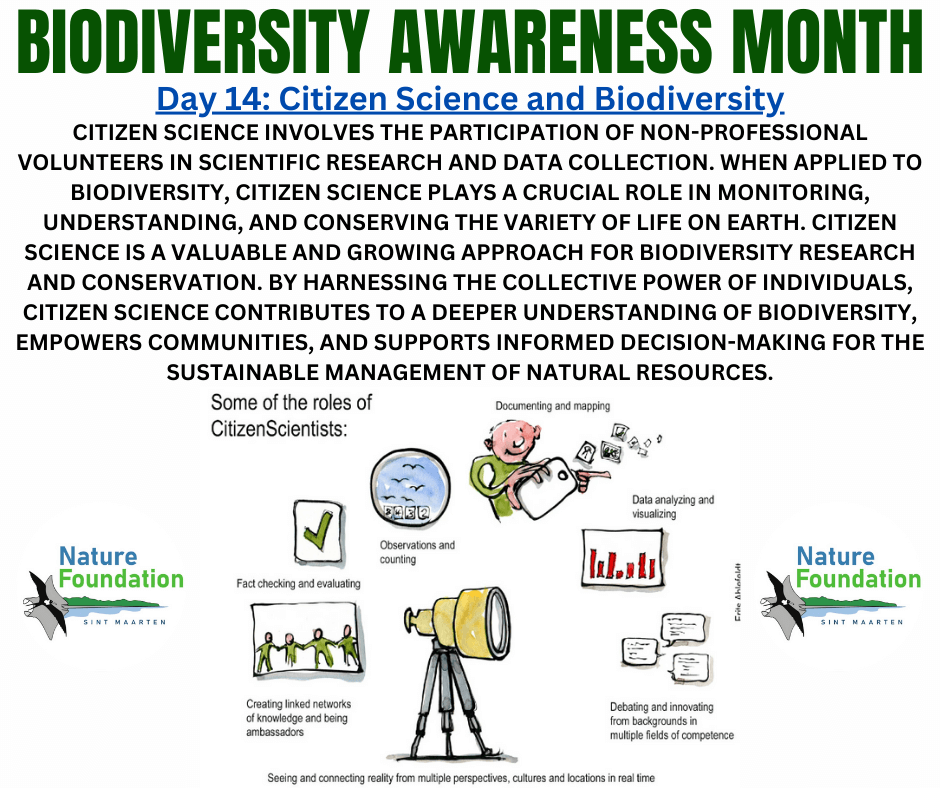Biodiversity month day 14: Citizen science and biodiversity
Citizen science involves the participation of non-professional volunteers in scientific research and data collection.
The St. Maarten Hospitality & Trade Association supports the March Biodiversity awareness month organized by the Nature Foundation in an effort to help protect St. Maartens nature and biodiversity. Todays topic: Citizen Science and Biodiversity
When applied to biodiversity, citizen science plays a crucial role in monitoring, understanding, and conserving the variety of life on Earth. Here are keyways in which citizen science contributes to biodiversity:
1. Data Collection: Citizen scientists contribute to the collection of large-scale and distributed data on biodiversity. They can help monitor plant and animal species, track migrations, and document changes in ecosystems over time. This data is valuable for scientific research and conservation efforts.
2. Increased Spatial and Temporal Coverage: With the help of citizen scientists, researchers can gather data from a wider geographical area and over longer periods than would be possible with a limited number of professionals. This increased coverage is especially important for studying dynamic and expansive ecosystems.
3. Species Identification: Citizen scientists often play a crucial role in species identification. Mobile apps and online platforms allow individuals to submit photos or observations, contributing to the compilation of species databases and aiding researchers in understanding species distributions.
4. Monitoring Invasive Species: Citizen science initiatives are instrumental in monitoring and reporting invasive species. Early detection of invasive species is vital for implementing timely management strategies to prevent or mitigate their negative impacts on local ecosystems.
5. Community Engagement: Citizen science fosters community engagement and awareness of biodiversity. Involving local communities in scientific projects enhances their understanding of the natural world and encourages a sense of stewardship toward their environment.
6. Education and Outreach: Citizen science projects provide educational opportunities for participants, allowing them to learn about the scientific process, biodiversity, and ecological systems. This hands-on experience can lead to increased environmental literacy and a deeper connection to nature.
7. Adaptive Management: Citizen science data can inform adaptive management strategies. The real-time or near-real-time data collected by volunteers can be used to adjust conservation and management plans based on current conditions and emerging trends.
8. Policy Advocacy: The collective data generated through citizen science initiatives can be a powerful tool for advocating policy changes and conservation measures. Robust scientific evidence from citizen science projects can influence decision-makers and promote better environmental policies.
9. Public Participation in Research: Citizen science democratizes scientific research by allowing individuals without formal scientific training to actively contribute to meaningful research projects. This inclusivity can lead to a more diverse and representative pool of contributors.
10. Global Collaboration: Citizen science often transcends national borders, enabling global collaboration on biodiversity research. Platforms and projects that engage citizens in different parts of the world facilitate the sharing of knowledge and the creation of a more comprehensive understanding of global biodiversity.
In summary, citizen science is a valuable and growing approach for biodiversity research and conservation. By harnessing the collective power of individuals, citizen science contributes to a deeper understanding of biodiversity, empowers communities, and supports informed decision-making for the sustainable management of natural resources.
Back to the Visit St Maarten Main page

